m a r s h |
h a v e n s
improving
marsh habitats for birds
in the Great Lakes basin |
|
|
GREAT LAKES MARSHES |
|
Common Moorhen / Peter LaTourrette |
Wetlands are among the most biologically productive ecosystems
in the Great Lakes basin. Marshes provide important habitats for
a wide variety of invertebrates, fish, amphibians, birds, and mammals.
Breeding birds rely on Great Lakes marshes for nesting cover and
to raise their young. Marshes also provide essential feeding and
staging habitat for many bird species during migration.
 |
Virginia Rail / Jim
Flynn |
The value of marshes can be easily overlooked. Obvious impacts
to marshes such as draining, dredging and filling, and some less
obvious efects such as water level stabilization, sedimentation,
nutrient enrichment, reduced adjacent natural lands, and exotic
species invasions have combined to drastically reduce the area and
condition of many Great Lakes marshes. Despite these widespread
losses and impacts to many important Great Lakes marshes, some remain
in relatively good condition and provide high quality habitat for
a wide variety of species.
 |
Bullfrog / Bird Studies
Canada |
In recent years, conservation efforts by various programs and organizations
have protected and enhanced many remaining Great Lakes marshes.
These efforts have begun to identify and restore marsh functions
that have been damaged or lost. Actions to enrich these ecosystems
are valuable for the health of birds, other wildlife, and the many
people who also rely on the vast basin for the necessities of life.
The status of marsh bird populations is recognized as an important
indicator of Great Lakes ecosystem health.
This fact sheet provides practical information to help guide habitat
management, conservation and stewardship practices to benefit marsh
birds in the Great Lakes region.
Ontario Ecosystems Under Pressure
Southern Ontario has the
most concentrated human population in Canada, resulting in
extensive impacts on the landscape. Detrimental effects on
biological diversity often arise from the cumulative impacts
of several stressors, such as habitat destruction and fragmentation,
environmental pollution, and climate change. All natural ecosystems
in the area are under intense pressure. These include forests,
grasslands, wetlands, rivers, and the Great Lakes.
Trade generated in the Great
Lakes basin is crucial to Canada’s economy. Annual Canada-United
States trade in this region is in excess of $180 billion.
This amount represents 45 percent of Canada’s industrial capacity
and 25 percent of its agricultural capacity. Economic activities
have had considerable impacts on the natural landscape, some
of which require remediation.
| 12 million people live
in Ontario |
| 10 million people live
in the Canadian Great Lakes basin |
| 40% of Canada’s species
at risk are in Ontario |
| 90% of Ontario’s Carolinian
forests have been lost |
| 70% of southern Ontario’s
wetlands have been lost |
|

Top
GREAT LAKES MARSH BIRDS |
| Great
Blue Heron / Peter LaTourrette |
Healthy Marsh Habitats For Healthy Marsh
Bird Communities
Great Lakes marshes have been destroyed or highly degraded by human
activities, resulting in losses of more than 50 percent of marsh
area in several Great Lakes states and more than 70 percent in southern
Ontario. A variety of marsh bird species have been negatively affected
because they are dependent on these disappearing habitats (e.g.,
Least Bittern, Black Tern, and Pied-billed Grebe). Several marsh
bird populations appear to be at risk due to continued marsh habitat
losses and degradation.
 |
Wet meadow / Steve
Timmermans |
Many marsh birds depend on healthy marsh habitats to complete their
life cycles. However, habitat needs for many species of marsh birds
are not well known, due in part to the secretive nature of some
species. One of the goals of the Marsh Monitoring Program is to
determine habitat associations of marsh bird species in the Great
Lakes basin. A good understanding of these relationships is critical
to designing and implementing effective marsh management, restoration,
and conservation practices.
The Marsh Monitoring Program
The Marsh Monitoring
Program * (MMP) has been
monitoring trends in marsh birds and calling amphibians in the Great
Lakes basin since 1995, using data provided by more than 600 volunteer
participants. Efforts by these citizen scientists to monitor and
evaluate the status of marsh birds and amphibians are essential
to understanding how well these marshes are functioning. Volunteer
participants conduct regular surveys of marsh birds (two 10-minute
evening surveys per year) and amphibians (three 3-minute evening
surveys per year) and provide descriptions of marsh habitat (percent
cover of plant and habitat types) at each survey station. To enquire
about participating in the MMP, call 1-888-448-2473.
 |
 |
Frogs and toads are surveyed at
night when their calling activity is usually greatest / Spring
peeper, Mary Gartshore |
MMP participants broadcast recorded
calls of secretive species (Virginia Rail, Sora, Least Bittern,
Common Moorhen, American Coot and Pied-billed Grebe) to help
elicit call responses and improve detection of these species
/ Ron Ridout |
 |
MMP participants broadcast recorded
calls of secretive species (Virginia Rail, Sora, Least Bittern,
Common Moorhen, American Coot and Pied-billed Grebe) to help
elicit call responses and improve detection of these species
/ Steve Timmermans |
Wetland Types |
|
Wetlands are areas that are seasonally or permanently covered
by shallow water, including areas where the water table is
close to or at the ground surface. These areas are dominated
by water-tolerant plant species. Large wetland complexes often
encompass more than one of the four main wetland types.
|
|
| Swamps |
Bogs |
|
Wetlands dominated by trees and shrubs, with periodic standing
water, limited drainage, and often neutral or slightly acidic
organic soils. |
Peat-accumulating glacially formed wetlands that trap precipitation
as the major water source, with typically acidic organic soils,
often containing Sphagnum mosses. |
|
| Marshes |
Fens |
|
Wetlands that are almost always flooded and characterized
by a mixture of emergent, floating, and submergent aquatic
vegetation. |
Peat-accumulating wetlands with groundwater as the dominant
water source. |
Marsh Bird
Population Trends
 |
Sora / Peter
LaTourrette |
Since the MMP was initiated in 1995, population trends for
certain Great Lakes marsh birds appear to be emerging. MMP
data in the figure below show only two marsh bird species
(Common Yellowthroat and Mallard) as experiencing significant
increases in abundance.
 |
Common Yellowthroat
/ Peter LaTourrette |
Conversely, populations of American Coot, Black Tern, Blue-winged
Teal, Common Moorhen/American Coot, Pied-billed Grebe, Red-winged
Blackbird, Sora, Tree Swallow, and Virginia Rail all appear
to be declining. Recent studies have found that population
changes for certain marsh birds in coastal marshes correlate
with fluctuations in lake levels.
|
Bird population trends (percent annual change)
that significantly increased (green) and decreased (red) from 1995
to 2002, as derived from MMP surveys

Top
GREAT LAKES MARSH HABITATS |
| Steve
Timmermans |
Plant communities are essential components of healthy marshes.
Their presence prevents flooding of adjacent uplands, promotes settling
of particulates from the water, and protects extensive areas from
wind and wave damage. A marsh’s habitat structure is largely based
on the composition and distribution of plant species. Water depth
is the key factor that determines the types and extent of vegetation
communities in wetlands. These vegetation communities occur in transitional
zones along depth gradients within wetlands.
 |
Marsh profile showing the transition
from upland habitat to deep permanently flooded zones. |
|
Species
Group |
Marsh
Habitat Use |
Species
Examples |
|
Birds |
Breeding, feeding,
migratory stopover, cover |
Sora, Black
Tern, Least Bittern |
|
Fish |
Spawning and
nursery, feeding, cover |
Northern pike,
largemouth bass, bluegill |
|
Amphibians |
Breeding, nursery,
feeding, cover |
Bullfrog, spring
peeper, mudpuppy |
|
Invertebrates |
Breeding, feeding,
cover |
Dragonfly, damselfly,
midge |
|
Mammals |
Breeding, feeding,
cover |
Beaver, muskrat,
mink |
| |
Habitat
Zone |
Definition |
Specific
Examples |
 |
Canadian Wildlife
Service |
|
Tree/Shrub |
Dominated
by water-tolerant woody plants. |
Willow,
dogwood, alder, buttonbush, soft maple, ash, cottonwood |
 |
Canadian Wildlife
Service |
|
Wet
Meadow |
Transitional
between woody and tall emergent. Subject to shallow flooding,
often moist to dry. |
Grasses,
sedges, forbs |
 |
Steve Timmermans |
|
Tall
Emergent |
Usually
flooded during entire growing season. |
Cattail,
reed grass, burreed, bulrush |
 |
Steve Timmermans |
|
Sparse
Broad-leaved Emergent |
Usually
shallow, continuously flooded vegetated areas. Roots of plants
submerged, but leaves and flowers above water’s surface. |
Arrowhead,
arrowarum, smartweed, pickerelweed |
 |
Steve Timmermans |
|
Floating
Aquatic |
Zones
where plants are either deep-rooted with leaves floating on
surface or with free floating non-rooted plants. Interspersed
through sparse emergents to open water zones. |
Water
lily, pondweed |
 |
Steve Timmermans |
|
Submerged
Aquatic |
Zones
where plants grow entirely underwater. Typically occur in
open water patches. |
Wild
celery, milfoil, coontail, pondweed |

Top
MARSH BIRD HABITAT NEEDS |
| Mallard
/ Peter LaTourrette |
Marsh Size
 |
Eastern Kingbirds
/ Jim Flynn |
Marsh size can influence the distribution, composition and complexity
of marsh habitats. Larger, more complex marshes with greater numbers
of habitat types are likely to attract greater numbers of bird species.
In addition, some species of birds are known to be “area-sensitive”,
meaning that they require marshes of a certain size threshold.
MMP results show that the size of a marsh can be used to predict
the relative frequency of occurrence of certain bird species. Figure
1a, for example, demonstrates considerable differences in expected
frequency of occurrence among bird species found in marshes that
are considered to be “small” (estimated area of 1 to 25 hectares).
While certain species, such as Eastern Kingbird, Song Sparrow and
Alder Flycatcher prefer small marshes, several other species do
not. Black Tern, American Coot, Marsh Wren, Least Bittern, Common
Moorhen and American Bittern are more likely to occur in larger
marshes. While there is a shortage of marshes of all sizes in the
Great Lakes basin, those that are greater than 25 hectares are in
shortest supply and in most need of conservation action.
 |
Figure 1a: Probable occurence
of selected bird species in small (1 - 25 hectare) marshes
as derived from MMP bird and habitat surveys in Great Lakes
marshes / Steve Timmermans |
Woody Vegetation
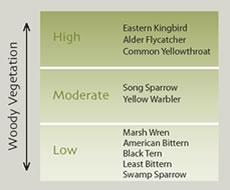 |
Figure 1b: Optimal
proportional coverage of woody vegetation in marsh habitats
for a selection of bird species, as derived from MMP bird
and habitat surveys in Great Lakes marshes. |
Certain types of trees and shrubs that prefer “wet feet” are frequently
found in woody vegetated zones of marshes, and provide important
habitat for an array of wetland bird species. Some of these birds
are considered “edge” species, because they are associated with
the transitional zone between aquatic and terrestrial habitats or
strictly with adjacent terrestrial zones. MMP results demonstrate
that a higher to moderate proportion of woody vegetation in marshes
is preferred among species such as Eastern Kingbird, Alder Flycatcher,
Common Yellowthroat, Song Sparrow and Yellow Warbler. Obligate marsh-nesting
species, such as Marsh Wren, American Bittern, Black Tern, and Least
Bittern, all have preferences for marshes with little to no woody
vegetation (Fig. 1b).
Wet Meadow
 |
Figure 1c: Optimal
proportional coverage of grasses and sedges in marsh habitats
for a selection of bird species, as derived from MMP bird
and habitat surveys in Great Lakes marshes. |
Wet meadow zones often separate deeper emergent zones from tree/shrub
and terrestrial zones. Wet meadow grasses and sedges can also intermix
with other permanent marsh zones, depending on stability and depth
of water levels. MMP data demonstrate that certain species tend
to be found in this kind of habitat, such as Song Sparrow, Common
Yellowthroat, Yellow Warbler, and Swamp Sparrow. Eastern Kingbird
and Willow Flycatcher both tend to prefer areas containing intermediate
proportions of grass and sedge cover. Conversely, this zone is largely
unsuitable for Pied-billed Grebe, Least Bittern, Marsh Wren, and
Common Moorhen (Fig. 1c).
Tall Emergent and Open Water
 |
Figure 1d: Optimal
proportional coverage of tall emergent vegetation in marsh
habitats for a selection of bird species, as derived from
MMP bird and habitat surveys in Great Lakes marshes. |
For many obligate marsh-dependent bird species, the proportion
of tall emergent cover (e.g., cattail) and presence of standing
water (both open water patches and water interspersed within emergent
zones) are critical habitat features. Analysis of MMP data demonstrates
that marshes containing high densities and proportions of tall emergent
vegetation, with relatively low proportion of open water, are preferred
by species such as Swamp Sparrow, American Bittern, and Marsh Wren
(Fig. 1d).
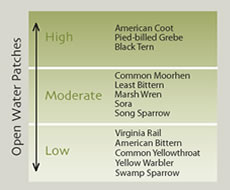 |
Figure 1e: Optimal
proportional coverage of open water patches in marsh habitats
for a selection of bird species, as derived from MMP bird
and habitat surveys in Great Lakes marshes. |
Conversely, tall emergent marshes that have relatively high proportions
of open water are preferred by such species as American Coot, Piedbilled
Grebe and Black Tern (Fig. 1e). Common Moorhen, Least Bittern, and
Marsh Wren are examples of species that have preferences for an
intermediate coverage of open water patches.

Top
IMPROVING MARSH BIRD HABITATS |
| Steve
Timmermans |
 |
Red-winged Blackbird
/ Ron Ridout |
Marsh birds rely on healthy and diverse marsh habitats; therefore,
any reduction of marsh habitat diversity, loss of certain habitat
components, or loss of natural hydrologic regimes could have marked
effects on specifc bird populations. For instance, marshes that
become “choked” with dense cattail stands can be unattractive habitat
for many marsh bird species. Providing ideal marsh habitat for marsh
birds and other wetland inhabitants typically involves establishing
a structurally diverse wetland.
Marsh managers should consider options for providing a diversity
of available vegetation habitats for a broad suite of bird species.
Some marsh birds need patches of tall, dense emergents, some need
wet meadow habitats, while yet others need a certain amount of woody
habitat. The number and size of open water patches, and how they
are interspersed among the stands of vegetation are also very important.
The ability to achieve biodiversity through restoration will vary
because marshes vary in their ability to support given vegetation
types.
Several options are available to encourage marsh habitat diversity.
Planning is critical for success. Some techniques are complex and
expensive, and professional advice should be sought. In addition,
application of some techniques may require approvals or permits
from government agencies.
Water Level Fluctuation
 |
Water level control
/ Wetland Habitat Fund |
Hydrology (dynamics of water abundance and flow) is the single
most important factor affecting composition and structure of vegetation
in marshes. Therefore, water level management can be an effective
method for controlling and restoring the density and diversity of
vegetation in marshes. Vegetation, in turn, creates nesting habitat
and protective cover. In addition to water depth, the duration,
frequency, timing and extent of water level fluctuations determine
the composition of marsh plant communities. Seasonally- or annually-variable
water levels tend to result in greater overall wetland plant diversity
than do static water levels.
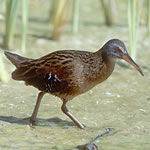 |
Virginia Rail / Peter
LaTourrette |
Wetland managers are able to regulate water levels by means of
dyking or berming, often in combination with the installation of
water control structures. Management activities can be expensive,
but water level management can be an extremely effective means to
flood out dense vegetation. Alternatively, water levels can be lowered
to temporarily dry out or draw down a marsh for plant rejuvenation.
Though generally beneficial for marsh birds, overly extensive dyking
or berming may have negative effects on coastal marsh fish communities.
Open Water Areas
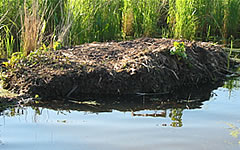 |
Muskrat-created
loafing platform / Steve Timmermans |
When densities of some wetland
plants become too high, marshes can become “choked”, and several
marsh bird species can be deterred from using the habitat.
For example, Pied-billed Grebe and Black Tern require marshes
with open water patches.
 |
Channel
/ Steve Timmermans |
In some cases, marsh managers
can physically create channels through wetland vegetation
(e.g., with excavation equipment), opening up a “choked” marsh
and increasing habitat complexity. Similar benefits can be
derived from managing muskrat and/or beaver populations. These
animals can be valuable tools for wetland management. Beavers
cause periodic flooding and draining of water bodies, which
is beneficial to marsh habitats. Muskrats create small open
pools of water and loafng areas. Sometimes, muskrats can over-exploit
their resources, and lead to a decline in emergent vegetation.
Nevertheless, with management (e.g., licensed trapping), their
presence can benefit a wide array of marsh bird species.
|
If water level regulation is not viable or beaver and muskrat activity
insufficient, there are other options to manage vegetation, including
disking, cutting, application of herbicides, and burning. Permits
are required for herbicide application. Caution and planning will
help prevent accidental environmental contamination during chemical
vegetation control.
 |
Controlled burn /
Paul Morris |
Burning is perhaps the most natural option of those listed, and
has been practised for many generations by North American First
Nations people. Careful planning is essential for a successful and
safe prescribed burn. While in the planning stages, advice should
be sought from local natural resource agencies. Permits are required
and are contingent on the municipality and local bylaws on burning.
The local fire department must give permission to conduct the burn
and successful application is more likely with a written burn plan
developed with professional input.
Burning dense emergent patches during the fall, winter or spring
once plants die off removes residual plant cover and releases nutrients
that promote wetland plant growth. It is important to time burns
during a period of anticipated water level increase. If water levels
can be controlled, burns should be followed by a period of sustained
high water levels to increase interspersion of open water patches.
Sediment Control
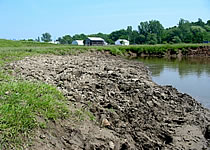 |
Degraded
stream / Steve Timmermans |
Marshes are productive ecosystems
because of nutrients that they receive and trap as water cycles
through their systems. However, too much sediment flowing
into a marsh can lead to high levels of water turbidity or
smothering, and limit aquatic vegetation growth, causing a
decline in overall marsh condition. This stress often occurs
where agriculture, logging or development causes soil to erode
from uplands or stream banks in the watershed.
 |
Alternative
cattle watering / Wetland Habitat Fund |
Best management practices,
such as promoting alternative livestock watering techniques,
will reduce soil erosion runoff, sediment movement, and deposition
in wetlands. Efforts should also be made to retire marginal
lands surrounding wetlands, keep livestock out of rivers and
streams, and stabilize river banks. The trend toward low tillage
in agricultural fields has reduced soil erosion and sediment
build-up in marshes.
|
 |
Native wetland plant
nursery / Steve Timmermans |
|
Marsh Vegetation Improvement
Wetland managers can speed up the process of creating suitable
marsh bird habitats by establishing desired plant species,
especially in newly created wetlands. A thorough understanding
of plant species ecology, hydrology and nature of the substrate
will improve success. Only locally sourced native species
should be considered for use, because these are adapted to
local growing conditions. If the marsh is large enough (e.g.,
5 hectares or more), consider options for providing a diversity
of vegetation habitats to suit a broad array of bird species. |
Physical Modification
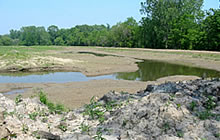 |
Pit and mound / Steve
Timmermans |
Marsh restoration may involve physically altering a wetland’s open
water to vegetation ratio to the desired interspersion of habitat
types. Excavating channels and pools with a dragline can achieve
the available range of water depths. A bulldozer or backhoe can
contour the marsh bottom. These management techniques can be costly
but can result in very positive long-term benefits to marsh birds
and other marsh species.
 |
Mature pit and mound
/ Wetland Habitat Fund |
The “pit and mound” technique involves piling up the soil that
is removed when digging scattered deep pools to create elevated
areas. Some mounds (but not necessarily all) may become islands.
In addition to creating a range of water levels, this technique
can save haulage and disposal fees. In large-scale marsh restoration
projects, it is best to create a variety of pit depths, which in
turn create a variety of mound elevations. Ensure that the banks
of the pool pits are not too steep.
Undesirable Exotic
Species
 |
Common reed
/ Long Point Waterfowl and Wetlands Research Fund |
Certain wetland plant and animal species are not native to
North America. Their activities and/or presence can be very
detrimental to native marsh species. Common Carp and Mute
Swans are exotic fish and bird species, respectively, that
can highly disturb or curtail submergent and even emergent
plant growth. Carp can be controlled by the use of draw downs,
fish barriers, and by trapping and netting. Managers can sometimes
obtain federal permits to remove Mute Swans when high numbers
of resident breeding individuals create significant turbidity
and cause damage to aquatic plant communities. Common reed
is an invasive tall emergent plant that can displace native
cattail stands, and can be controlled by disking, herbicide
application, or controlled burns. In general, try to keep
the marsh free of all exotic plant and animal species.
|

Top
TIPS FOR SUCCESS |
| Blue-winged
Teal / Peter LaTourrette |
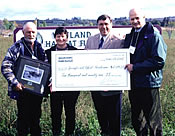 |
Wetland Habitat Fund |
Careful planning is central to the success of any habitat restoration
or enhancement project. There are many steps to take before actually
making changes to any marsh. The long-term success of the project
will be determined mainly by careful timing of each project stage,
including maintenance that may be required in subsequent seasons.
Take the time to research and source the best advice and expertise,
materials and equipment, and all supplies needed for any project.
The first step should be to seek assistance and potential financial
support from experts in the field. In Canada, both Ducks Unlimited
Canada and the Wetland Habitat Fund offer particular expertise in
marsh restoration and creation (see Contacts).
Bigger is Better
When it comes to marsh habitats, bigger is definitely better. Species
that are of particular conservation concern in the Great Lakes basin
tend to be area-sensitive, such as Black Tern, Pied-billed Grebe,
Least Bittern, and American Bittern. A 10-hectare marsh, or a complex
of 10 small marshes that are closely associated is much more valuable
to birds (and other wildlife) than are 10 one-hectare marshes that
are widely separated and non-associated. The ideal combination is
a complex containing a large marsh in conjunction with many smaller
ones.
Variety is the Spice of Marsh Life
 |
Pied-billed Grebe
/ Peter LaTourrette |
Structural diversity is the second most important ingredient for
attracting marsh birds. Structural diversity of marsh habitats can
be greatly enhanced through having a variety of water levels present
in the marsh, ranging from shallow to deep (up to two metres). This
will ensure that there are always areas of open water and that wetlands
do not become choked by dense mats of cattail within a few years.
Physically contouring the wetland bottom to achieve this diversity
is part science and part art. In almost all cases, avoid steep-sided
drop-offs, particularly around the marsh perimeter. Gentle slopes
are almost always best and are most effective in emulating natural
marsh conditions.
Protect Your Investment
 |
Green Heron / Peter
LaTourrette |
Natural vegetation between marshes and adjacent land uses provides
valuable cover for birds and other wildlife, and reduces erosion
and pollution from run-off. The amount of adjacent natural vegetation
for wildlife purposes should be site- and species-specific, considering
the critical area of adjacent upland that marsh wildlife species
require for part of their life cycle. For example, for Wood Ducks
or Mallards that nest in woodlands or meadows surrounding marshes,
the availability of nesting habitats adjacent to marshes is critical.
At least 100 metres of adjacent natural vegetation should be considered.
Adjacent uplands will establish naturally with species that occur
in the seed bank, but planting native trees, shrubs, prairie plants,
or simple grasses and clovers can aid natural processes.
Looking Ahead
 |
Steve Timmermans |
It is hoped that the information in this fact sheet will be used
in conjunction with other available information sources to help
guide efforts to restore and create marsh habitats in the Great
Lakes basin. While the focus here is on helping to maintain healthy
and diverse bird populations in marshes, these approaches also benefit
a wide variety of wildlife and plants that depend on these habitats.
Even small additions of marsh habitat area and function will help
regain the major historical losses that these important environments
have incurred. Collectively, our efforts to restore marsh environments
will help ensure a sustainable and healthy future for the environment.
Recommended Reading
Environment Canada and Ontario Ministry of Natural Resources. 1997.
Working around wetlands? What you should
know. Canadian Wildlife Service – Ontario Region, Toronto, Ontario.
Environment Canada. 1996. Planting
the Seed: A Guide to Establishing Aquatic Plants. Canadian Wildlife
Service – Ontario Region, Toronto, Ontario.
Environment Canada. 2002. Where Land Meets Water: Understanding
Wetlands of the Great Lakes. Environment Canada, Toronto, Ontario.
Mansell, W.D., L. Christl, R. Maher, A. Norman, N. Patterson, and
T. Whillans. 1998. Temperate Wetlands Restoration Guidelines. Ontario
Ministry of Natural Resources, Environment Canada, and Ducks Unlimited
Canada.
Society for Ecological Restoration – Ontario Chapter. 2004. 2004
–2005 Native Plant Resource Guide for Ontario. Information and sources
of planting materials for ecological restorationists in Ontario.
Contacts
Canadian Wildlife Service - Ontario Region
Environment Canada
4905 Dufferin Street
Downsview, ON M3H 5T4
(416) 739-5830
www.on.ec.gc.ca/wetlands
Ducks Unlimited Canada
Provincial Office
566 Welham Road
Barrie, ON L4N 8Z7
(705) 721-4444
www.ducks.ca/province/on
*
Ontario Ministry of Natural Resources
1-800-667-1940
www.mnr.gov.on.ca *
Ontario Ministry of Natural Resources, Ontario
Stewardship
P.O. Box 7000, 300 Water St. 4th Floor South Tower
Peterborough, ON K9J 8M5
(705) 755-3206
www.ontariostewardship.org
*
Wetland Habitat Fund
A program of the Eastern Habitat Joint Venture.
310-1750 Courtwood Crescent
Ottawa, ON K2C 2B5
1-800-669-7919 ext 248
www.whc.org/wetlandfund/
*
Wildlife Habitat Canada
310-1750 Courtwood Crescent
Ottawa, ON K2C 2B5
1-800-669-7919
www.whc.org *
Acknowledgements
The Marsh Monitoring Program is delivered binationally across the
Great Lakes basin by Bird Studies Canada, in partnership with Environment
Canada’s Canadian Wildlife Service - Ontario Region and the United
States Environmental Protection Agency’s Great Lakes National Program
Office. Thanks to Lesley Dunn, Mike Gendron, Kathy Jones, Claudia
Latsch, Ron Maher, Paul Morris, Julie Suzanne Pollock, Mark Stabb,
and Ed Wiken for their help in producing this document. Special
thanks to all the MMP participants for volunteering their time to
complete bird, amphibian and habitat surveys in hundreds of Great
Lakes basin marshes, and for providing their data that made many
of the results in this document possible.
Photo on front cover: Steve Timmermans
© Bird Studies Canada, 2004. No portion of this document may
be reproduced without the express written consent of Bird Studies
Canada.
Authors: Steve Timmermans and Jon McCracken
Graphic Design: Espresso Consulting & Design
For more information
Bird Studies Canada
P.O. Box 160
Port Rowan, ON N0E 1M0
1-888-448-BIRD(2473)
www.bsc-eoc.org *
Production of this fact sheet, and the work completed by Bird Studies
Canada to provide this information, were supported by the following:


Click here
to view / print this document in PDF format

Top
|